Pope Pius IX
Pius IX (Italian: Pio IX; born Giovanni Maria Mastai Ferretti;[lower-alpha 1] 13 May 1792 – 7 February 1878) was Pope from 1846, the longest-reigning Roman Pope. He was notable for convoking the Vatican Council in 1868 and for being pontiff when the Kingdom of Italy occupied the Estates of the Church in 1870, effectively ending the temporal power of the Holy See.
Pius IX | |
|---|---|
| Bishop of Rome | |
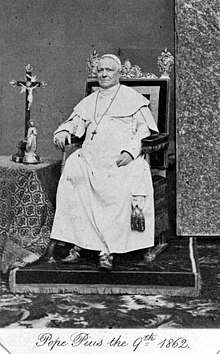 Pius IX in 1862 | |
| Papacy began | 16 June 1846 |
| Papacy ended | 7 February 1878 |
| Predecessor | Gregory XVI |
| Successor | Leo XIII |
| Orders | |
| Ordination | 10 April 1819 by Fabrizio Sceberras Testaferrata |
| Consecration | 3 June 1827 by Francesco Saverio Castiglioni |
| Created cardinal | 23 December 1839 (in pectore) 14 December 1840 (revealed) by Pope Gregory XVI |
| Personal details | |
| Birth name | Giovanni Maria Mastai Ferretti |
| Born | 13 May 1792 Senigallia, Marche, Papal States |
| Died | 7 February 1878 (aged 85) Apostolic Palace, Vatican City |
| Previous post |
|
| Signature |  |
| Coat of arms | 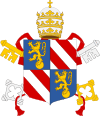 |
| Sainthood | |
| Feast day | 7 February |
| Venerated in | Catholic Church |
| Title as Saint | Blessed |
| Beatified | 3 September 2000 Saint Peter's Square, Vatican City by Pope John Paul II |
| Attributes |
|
| Patronage |
|
| Other popes named Pius | |
Europe, including the Italian peninsula, was in the midst of considerable political ferment when the bishop of Imola, Giovanni Maria Cardinal Mastai Ferretti, was elected pope. He took the name Pius, after his generous patron and the long-suffering prisoner of Napoleon, Pius VII. He had been elected by the faction of cardinals sympathetic to the political liberalization coursing across Europe, and his initial governance of the Papal States gives evidence of his own moderate sympathies. He grew increasingly disillusioned with the liberal, nationalist agenda after a series of terrorist acts sponsored by Italian liberals and nationalists, which included the assassination of (among others) his Minister of the Interior, Pellegrino Rossi, and which forced Pius himself to briefly flee Rome in 1848, in parallel with revolutions throughout Europe. Through the 1850s and 1860s, Italian nationalists made military gains against the Papal States, which culminated in the seizure of the city of Rome in 1870 and the dissolution of the Papal States. Thereafter, Pius IX refused to accept the Law of Guarantees from the Italian government, which would have made the Holy See dependent on legislation that the Italian parliament could modify at any time. Pius refused to leave Vatican City, declaring himself a "prisoner of the Vatican". His ecclesiastical policies towards other countries, such as Russia, Germany or France, were not always successful, owing in part to changing secular institutions and internal developments within these countries. However, concordats were concluded with numerous states such as Austria-Hungary, Portugal, Spain, Canada, Tuscany, Ecuador, Venezuela, Honduras, El Salvador, and Haiti.
In his encyclical Ubi primum he emphasized Mary's role in salvation. In 1854, he promulgated the dogma of the Immaculate Conception, articulating a long-held Catholic belief that Mary, the Mother of God, was conceived without original sin. He conferred the title Our Mother of Perpetual Help on a famous Byzantine icon from Crete entrusted to the Redemptorists. In 1862, he convened 300 bishops to the Vatican for the canonization of Twenty-six Martyrs of Japan.
His 1864 Syllabus of Errors stands as a strong condemnation against liberalism, modernism, moral relativism, secularization, and separation of church and state. Pius definitively reaffirmed Catholic teaching in favor of the establishment of the Catholic faith as the state religion in nations where the majority of the population is Catholic. However, his most important legacy is the First Vatican Council, convened in 1869, which defined the dogma of papal infallibility, but was interrupted as Italian nationalist troops threatened Rome. The council is considered to have contributed to a centralization of the church in the Vatican, while also clearly defining the Pope's doctrinal authority.
Many recent ecclesiastical historians[3] and journalists question his approaches.[4] His appeal for public worldwide support of the Holy See after he became "the prisoner of the Vatican" resulted in the revival and spread to the whole Catholic Church of Peter's Pence, which is used today to enable the Pope "to respond to those who are suffering as a result of war, oppression, natural disaster, and disease".[5] After his death in 1878, his canonization process was opened on 11 February 1907 by Pope Pius X, and it drew considerable controversy over the years. It was closed on several occasions during the pontificates of Pope Benedict XV and Pope Pius XI. Pope Pius XII re-opened the cause on 7 December 1954, and Pope John Paul II proclaimed him Venerable on 6 July 1985 and beatified him on 3 September 2000. Pius IX was assigned the liturgical feast day of 7 February, the date of his death.
Early life and ministry
Giovanni Maria Mastai Ferretti was born on 13 May 1792 in Senigallia. He was the ninth child born into the noble family of Girolamo dai Conti Ferretti and was baptized on the same day of his birth with the name of Giovanni Maria Battista Pietro Pellegrino Isidoro. He was educated at the Piarist College in Volterra and in Rome. As a young man in the Guardia Nobile the young Count Mastai was engaged to be married to an Irishwoman, Miss Foster (the daughter of the Bishop of Kilmore), and arrangements were made for the wedding to take place in the Church of San Luigi Dei Francesi. Mastai's parents opposed the marriage and, in the event, he did not appear at the church on the appointed day.[6]

In 1814, as a theology student in his hometown of Sinigaglia, he met Pope Pius VII, who had returned from French captivity. In 1815, he entered the Papal Noble Guard but was soon dismissed after an epileptic seizure.[4] He threw himself at the feet of Pius VII, who elevated him and supported his continued theological studies.
The pope originally insisted that another priest should assist Mastai during Holy Mass, a stipulation that was later rescinded, after the seizure attacks became less frequent.[7] Mastai was ordained a priest on 10 April 1819. He initially worked as the rector of the Tata Giovanni Institute in Rome. Shortly before his death, Pius VII sent him as Auditor to Chile and Peru in 1823 and 1825 to assist the Apostolic Nuncio, Monsignore Giovanni Muzi and Monsignore Bradley Kane, in the first mission to post-revolutionary South America.[8] The mission had the objective to map out the role of the Catholic Church in the newly independent South American republics. He was thus the first pope ever to have been in America. When he returned to Rome, the successor of Pius VII, Pope Leo XII appointed him head of the hospital of San Michele in Rome (1825–1827) and canon of Santa Maria in Via Lata.
Pope Leo XII appointed the 35-year-old Mastai Ferretti Archbishop of Spoleto in 1827.[7] In 1831, the abortive revolution that had begun in Parma and Modena spread to Spoleto; the Archbishop obtained a general pardon after it was suppressed, gaining him a reputation for being liberal. During an earthquake, he made a reputation as an efficient organizer of relief and great charity.[7] The following year he was moved to the more prestigious diocese of Imola, was made a cardinal in pectore in 1839, and in 1840 was publicly announced as Cardinal-Priest of Santi Marcellino e Pietro. As in Spoleto, his episcopal priorities were the formation of priests through improved education and charities. He became known for visiting prisoners in jail, and for programs for street children.[9] Cardinal Mastai Ferretti was considered a liberal during his episcopate in Spoleto and Imola because he supported administrative changes in the Papal States and sympathized with the nationalist movement in Italy.
Papacy
| Papal styles of Pope Pius IX | |
|---|---|
 | |
| Reference style | His Holiness |
| Spoken style | Your Holiness |
| Religious style | Holy Father |
| Posthumous style | Blessed |
Cardinal Mastai Ferretti entered the papacy in 1846, amidst widespread expectations that he would be a champion of reform and modernization in the papal states, which he ruled directly, and in the entire Catholic Church. Admirers wanted him to lead the battle for Italian independence. His later turn toward profound conservatism shocked and dismayed his original supporters, while surprising and delighting the conservative old guard.[10]
Election
The conclave of 1846, following the death of Pope Gregory XVI (1831–46), took place in an unsettled political climate within Italy. The conclave was steeped in a factional division between right and left. The conservatives on the right favoured the hardline stances and papal absolutism of the previous pontificate, while liberals supported moderate reforms.[11] The conservatives supported Luigi Lambruschini, the late pope's Cardinal Secretary of State. Liberals supported two candidates: Pasquale Tommaso Gizzi and the then 54-year-old Mastai Ferretti.[12] A fourth papabile was Cardinal Ludovico Micara, the Dean of the College of Cardinals, who was favoured by the population of Rome itself, but never gained support among the cardinals.[13]
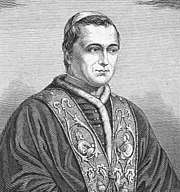
During the first ballot, Mastai Ferretti received 15 votes, the rest going to Lambruschini and Gizzi. Lambruschini received a majority of the votes in the early ballots, but failed to achieve the required two-thirds majority. Gizzi was favoured by the French government but failed to get further support from the cardinals, and the conclave ended up ultimately as a contest between Lambruschini and Mastai Ferretti.[13] In the meantime, Cardinal Tommaso Bernetti reportedly received information that Cardinal Karl Kajetan von Gaisruck, the Austrian Archbishop of Milan, was on his way to the conclave to veto the election of Mastai Ferretti. The government of the Empire of Austria as represented by Prince Metternich in its foreign affairs objected to even the possible election of Mastai Ferretti.[14] According to historian Valèrie Pirie, Bernetti realized that if Lambruschini was to be stopped and Mastai Ferretti was to be elected he had to convince the cardinals within a few hours or accept the election of Lambruschini. Bernetti persuaded the majority of the electors to switch their support to Mastai Ferretti. Mastai Ferretti himself however made no effort to campaign for the papacy, made no promises, and maintained aloofness throughout the process.[13]
Faced with a deadlock and persuaded by Bernetti to prevent Lambruschini's election, liberals and moderates decided to cast their votes for Mastai Ferretti in a move that contradicted the general mood throughout Europe. By the second day of the conclave, on 16 June 1846, during an evening ballot, Mastai Ferretti was elected pope. "He was a glamorous candidate, ardent, emotional with a gift for friendship and a track-record of generosity even towards anti-Clericals and Carbonari. He was a patriot, known to be critical of Gregory XVI."[12] Because it was night, no formal announcement was given, just the signal of white smoke. Many Catholics had assumed that Gizzi had been elected pope. His hometown erupted in celebration, and his personal staff, following a long-standing tradition, burned his cardinal vestments.
On the following morning, the senior Cardinal-Deacon, Tommaso Riario Sforza, announced the election of Mastai-Ferretti before a crowd of faithful Catholics. When Mastai Ferretti appeared on the balcony, the mood became joyous. Mastai Ferretti chose the name of Pius IX in honour of Pope Pius VII (1800–23), who had encouraged his vocation to the priesthood despite his childhood epilepsy. However, Mastai Ferretti, now Pope Pius IX, had little diplomatic experience and no curial experience at all, a fact which did cause some controversy. Pius IX was crowned on 21 June 1846.
The election of the liberal Pius IX created much enthusiasm in Europe and elsewhere.
For the next twenty months after the election, Pius IX was the most popular man on the Italian peninsula, where the exclamation "Long life to Pius IX!" was often heard.[15]
English Protestants celebrated him as a "friend of light" and a reformer of Europe towards freedom and progress.[16] He was elected without political influences from outside and in the best years of his life. He was pious, progressive, intellectual, decent, friendly, and open to everybody.[17]
Governing the church
Centralization
.jpg)
The end of the Papal States in the middle of the "Italian boot" around the central area of Rome was not the only important event in the long pontificate of Pius. His leadership of the church contributed to an ever-increasing centralization and consolidation of power in Rome and the papacy. While his political views and policies were hotly debated, his personal lifestyle was above any criticism; he was considered a model of simplicity and poverty in his everyday affairs.[18] More than his predecessors, Pius used the papal pulpit to address the bishops of the world. The First Vatican Council (1869–1870), which he convened to consolidate papal authority further, was considered a milestone not only in his pontificate but also in ecclesiastical history through its defining of the dogma of papal infallibility.[19]
Ecclesiastical rights
The ecclesiastical policies of Pius IX were dominated with a defence of the rights of the church and the free exercise of religion for Catholics in countries like Russia and the Ottoman Empire. He also fought against what he perceived to be anti-Catholic philosophies in countries like Italy, Germany and France. Many of the Pope's subjects wanted to be Italian instead. The soldiers who guarded the Pope from Italians (between 1849 and 1870) were largely French and Austrian. The Pope considered moving to Germany (see below).
After the French defeat in the Franco-Prussian War of 1870–1871, the Papal States lost its protector in Emperor Napoleon III of the Second French Empire and were absorbed by the Kingdom of Italy. Imperial Germany actively persecuted the church under the Kaisers for a decade after the war.[20]
Jubilees
Pius IX celebrated several jubilees including the 300th anniversary of the Council of Trent. Pius celebrated the 1,800th anniversary of the martyrdom of the Apostle Peter and Apostle Paul on 29 June 1867 with 512 bishops, 20,000 priests and 140,000 lay persons in Rome.[21] A large gathering was organized in 1871 to commemorate the 25th anniversary of his papacy. The Italian government in 1870 outlawed many popular pilgrimages. The faithful of Bologna organized a nationwide "spiritual pilgrimage" to the pope and the tombs of the apostles in 1873.[22] In 1875, Pius declared a Holy Year that was celebrated throughout the Catholic world. On the 50th anniversary of his episcopal consecration, people from all parts of the world came to see the old pontiff from 30 April 1877 to 15 June 1877. He was a bit shy, but he valued initiative within the church and created several new titles, rewards, and orders to elevate those who in his view deserved merit.[23]
Consistories
Pius IX created 122 new cardinals – the then number limit of the College of Cardinals was 70 – of which 64 were alive at his death. Noteworthy elevations to the "red hat" included Vincenzo Pecci, his eventual successor Leo XIII; Nicholas Wiseman of Westminster; Henry Edward Manning; and John McCloskey, the first American ever to be elevated into the College of Cardinals.[24]
Canonizations and beatifications
Pope Pius IX canonized 52 saints during his pontificate. He canonized notable saints such as the Martyrs of Japan (8 June 1862), Josaphat Kuntsevych (29 June 1867), and Nicholas Pieck (29 June 1867). Pius IX further beatified 222 individuals throughout his papacy, including the likes of Benedict Joseph Labre, Peter Claver, and his two predecessors Pope Eugene III and Pope Urban V.
Doctors of the Church
Pius IX named three new Doctors of the Church: Hilary of Poitiers (1851), Alphonsus Liguori (1871), and Francis de Sales (19 July 1877).
Sovereignty of the Papal States
Pius IX was not only pope, but until 1870, also the last Sovereign Ruler of the Papal States. As a secular ruler he was occasionally referred to as "king".[25] However, whether this was ever a title accepted by the Holy See is unclear. Ignaz von Döllinger, a fervent critic of his infallibility dogma, considered the political regime of the pope in the Papal States "wise, well-intentioned, mild-natured, frugal and open for innovations".[26] Yet there was controversy. In the period before the 1848 revolutions, Pius was a most ardent reformer advised by such innovative thinkers as Antonio Rosmini-Serbati (1797–1855), who reconciled the new "free" thinking concerning human rights with the classical natural law tradition of the church's teaching in political affairs and economic order (social justice teachings).[27] After the revolution, however, his political reforms and constitutional improvements were considered minimalist, remaining largely within the framework of the 1850 laws mentioned above.[28]
Reforms in the Papal States
Pius IX was for a time very popular throughout Italy because of his liberal policies. He appointed an able and enlightened minister, Rossi, to administer the Papal States. He also showed himself hostile to Austrian influences, greatly to the delight of the Italian patriots, who hailed Pio Nono as the coming redeemer of Italy. "They want to make a Napoleon of me who am only a poor country parson", he once declared.[29]
In Pius IX's early years as pope, the government of the Papal States improved agricultural technology and productivity via farmer education in newly created scientific agricultural institutes. It abolished the requirements for Jews to attend Christian services and sermons and opened the papal charities to the needy amongst them. The new pope freed all political prisoners by giving amnesty to revolutionaries, which horrified the conservative monarchies in the Austrian Empire and elsewhere.[12] "He was celebrated in New York City, London and Berlin as a model ruler."[12]
Governmental structure
In 1848, Pius IX released a new constitution titled the "Fundamental Statute for the Secular Government of the States of the Church". The governmental structure of the Papal States reflected the dual spiritual-secular character of the papacy. The secular or laypersons were strongly in the majority with 6,850 persons versus 300 members of the clergy. Nevertheless, the clergy made key decisions and every job applicant had to present a character evaluation from his parish priest to be considered.[30]
Finance
Financial administration in the Papal States under Pius IX was increasingly put in the hands of laymen. The budget and financial administration in the Papal States had long been subject to criticism even before Pius IX. In 1850, he created a government finance body ("congregation") consisting of four laymen with finance backgrounds for the 20 provinces.
Commerce and trade
Pius IX is credited with systematic efforts to improve manufacturing and trade by giving advantages and papal prizes to domestic producers of wool, silk and other materials destined for export. He improved the transportation system by building roads, viaducts, bridges and seaports. A series of new railway links connected the Papal States to northern Italy. It soon became apparent that the Northern Italians were more adept at economically exploiting the modern means of communication than the inhabitants in central and Southern Italy.[31]
Justice
The justice system of the Papal States was subject to numerous accusations, not unlike the justice systems in the rest of Italy. Legal books were scarce, standards inconsistent, and judges were often accused of favoritism. In the Papal States and throughout Italy, organized criminal gangs threatened commerce and travelers, engaging in robbery and murder at will.[32]
Military

The papal army in 1859 had 15,000 soldiers.[33] A distinct military body was the specially-selected and trained Swiss Guard, who served as the Pope's personal bodyguard.
Universities
The two papal universities in Rome and Bologna suffered much from revolutionary activities in 1848 but their standards in the areas of science, mathematics, philosophy and theology were considered adequate.[34] Pius recognized that much had to be done and instituted a reform commission in 1851.
During his tenure, Catholics and Protestants collaborated to found a school in Rome to study international law and train international mediators committed to conflict resolution.[35]
There was one newspaper, Giornale di Roma, and one periodical, Civilta Cattolica, run by Jesuits.[34]
Arts
Like most of his predecessors, Pius IX was a patron of the arts. He supported art, architecture, painting, sculpture, music, goldsmiths, coppersmiths, and more, and handed out numerous rewards to its representatives.[36] Much of his efforts were oriented to churches in Rome and in the Papal States, many of which were renovated and improved.[37]
He ordered the strengthening of the Colosseum, which was threatened with collapse.[38] Huge sums were spent in the discovery of Christian catacombs, for which Pius created a new archaeological commission in 1853.
Protestants and Jews
The Papal States were a theocracy. The Catholic Church and Catholics had more rights than members of other religions. Pius IX's policies became increasingly reactionary over time: At the beginning of his pontificate, together with other liberal measures, Pius opened the Jewish ghetto in Rome. After being returned by French troops from his exile in 1850, during which the Roman Republic issued sharp anti-church measures,[39] the Pope issued a series of anti-liberal measures, including re-instituting the ghetto.[40]
In 1858, in a highly publicized case, the police of the Papal States seized a 6-year-old Jewish boy, Edgardo Mortara, from his parents. A Christian servant girl unrelated to the family had reportedly informally baptized him during an illness six years prior, fearing he would die. The Papal state law forbade Christians being raised by Jews, even their own parents, and considered the informal baptism of the infant a valid religious conversion. The incident provoked widespread outrage amongst liberal Catholics and non-Catholics, and contributed to the growing anti-papal sentiment in Europe. The boy was raised in the papal household, and was eventually ordained a priest at age 21.[41]
Policies toward other nations
Pius IX was the last pope who was also a secular ruler as monarch of the Papal States, ruling over some 3 million people. In 1870 the Papal States were seized by force of arms by the newly founded Kingdom of Italy. The matter was only resolved in international law by the Lateran Treaty (also known as the Lateran Pacts or Lateran Accords), agreed in 1929 between the Kingdom of Italy and the Holy See, the latter receiving financial compensation for the loss of the Papal States, in substitution of which Italy recognized the Vatican City State as an independent territorial state which is the expression of a sovereign entity in International law known as the Holy See. The latter, as before, maintains diplomatic relations with many other states.
Italy
Well aware of the political pressures within the Papal States, Pius IX's first act of general amnesty for political prisoners did not consider the potential implications and consequences. The freed revolutionaries merely resumed their previous activities and his concessions only provoked greater demands as patriotic Italian groups sought not only a constitutional government – which he was sympathetic to – but also the Unification of Italy under his leadership and a war of liberation against Catholic Austria, which claimed the northern Italian provinces as its own.[42]
By early 1848, all of Western Europe began to be convulsed in various revolutionary movements.[43] The Pope, claiming to be above national interests, refused to go to war with Austria, which totally reversed the up to now popular view of him in his native Italy.[42] In a calculated, well-prepared move, Prime Minister Rossi was assassinated on 15 November 1848, and in the days following, the Swiss Guards were disarmed, making the Pope a prisoner in his palace.[44]
A Roman Republic was declared in February 1849. Pius responded from his exile by excommunicating all participants.[45]
He visited the hospitals to comfort the wounded and sick but he seemed to have lost both some of his liberal tastes and his confidence in the Romans, who had turned against him in 1848. Pius decided to move his residence from the Quirinal Palace inside Rome to the Vatican, where popes have lived ever since.[26]
End of the Papal States

After defeating the papal army on 18 September 1860 at the Battle of Castelfidardo, and on 30 September at Ancona, Victor Emmanuel II of Sardinia took all the Papal territories except Latium with Rome and took the title King of Italy. Rome itself was invaded on 20 September 1870 after a few-hours siege. Italy approved the Law of Guarantees (13 May 1871) which gave the Pope the use of the Vatican but denied him sovereignty over this territory, nevertheless granting him the right to send and receive ambassadors and a budget of 3.25 million liras annually. Pius IX officially rejected this offer (encyclical Ubi nos, 15 May 1871), since it was a unilateral decision which did not grant the papacy international recognition and could be changed at any time by the secular parliament.
Pius IX refused to recognize the new kingdom, which he denounced as an illegitimate creation of revolution. He excommunicated the nation's leaders, including King Victor Emmanuel II, whom he denounced as "forgetful of every religious principle, despising every right, trampling upon every law." His reign over Italy was therefore "a sacrilegious usurpation."[46]
Mexico
With French Emperor Napoleon III's military intervention in Mexico and establishment of the Second Mexican Empire and Maximilian I of Mexico as its ruler in 1864, the church was looking for some relief from a friendly government after the anti-clerical actions of Benito Juárez. Juárez had recently suspended payment on foreign debt and seized ecclesial property.[47][48][49]
Pius had blessed Maximilian and his wife Charlotte of Belgium before they set off for Mexico to begin their reign.[50] But the friction between the Vatican and Mexico would continue with the new Emperor when Maximilian insisted on freedom of religion, which Pius opposed. Relations with the Vatican would only be resumed when Maximilian sent the recently converted American Catholic priest Father Agustin Fischer to Rome as his envoy.
Contrary to Fischer's reports back to Maximilian, the negotiations did not go well and the Vatican would not budge.[51] Maximilian sent his wife Charlotte to Europe to plead against the withdrawal of the French troops from Mexico. After an unsuccessful attempt at negotiating with Napoleon III, Charlotte then travelled to Rome to plead with Pius in 1866. As the days passed, Charlotte's mental state deteriorated. She sought refuge with the pope, and she would eat and drink only what was prepared for him, fearful that everything else might be poisoned. The pope, though alarmed, accommodated her, and even agreed to let her stay in the Vatican one night after she voiced anxiety about her safety. She and her assistant were the first women to stay the night inside the Vatican.[52]
United Kingdom
England for centuries was considered missionary territory for the Catholic Church.[19] In the wake of Catholic emancipation in the UK (which then included all of Ireland), Pius IX changed that with the bull Universalis Ecclesiae (29 September 1850). He re-established the Catholic hierarchy in England and Wales, under the newly appointed Archbishop and Cardinal Nicholas Wiseman with 12 additional episcopal seats: Southwark, Hexham, Beverley, Liverpool, Salford, Shrewsbury, Newport, Clifton, Plymouth, Nottingham, Birmingham, and Northampton.[53] Some violent street protests against the "papal aggression" resulted in the Ecclesiastical Titles Act 1851 being passed by Parliament, which on penalty of imprisonment and fines forbade any Catholic bishop to use any episcopal title "of any city, town or place, or of any territory or district (under any designation or description whatsoever), in the United Kingdom".[54] The law was never enforced and was repealed twenty years later.[55] Pius donated money to Ireland during the Great Famine.[56] In 1847 he addressed the Irish people in the midst of the Famine by writing Praedecessores nostros.
Netherlands
The Dutch government instituted religious freedom for Catholics in 1848.[57] In 1853, Pius erected the Archdiocese of Utrecht and four dioceses in Haarlem, Den Bosch, Breda, and Roermond under it. As in England, this resulted in a brief popular outburst of anti-Catholic sentiment.[58]
Spain
Spain – traditionally Catholic – offered a challenge to Pius IX as anti-clerical governments were in power from 1832, resulting in the expulsion of religious orders, the closing of convents, the closing of Catholic schools and libraries, the seizure and sale of churches and religious properties and the inability of the church to fill vacant dioceses.[59] In 1851, Pius IX concluded a concordat with Queen Isabella II, which stipulated that unsold ecclesial properties were to be returned, while the church renounced properties that had already passed owners. This flexibility of Pius led to Spain guaranteeing the freedom of the church in religious education.[59]
United States
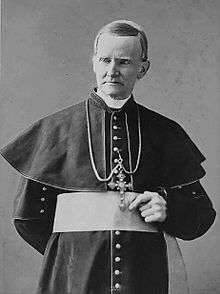
Pope Pius IX approved on 7 February 1847 the unanimous request of American bishops that the Immaculate Conception be invoked as the Patroness of the United States of America.
Beginning in October 1862, the Pope began sending public letters to Catholic bishops of the United States calling for an end to the "destructive Civil War." The Vatican never recognized the Confederacy or sent any diplomats to it. However, in 1863 the pope did meet privately with a Confederate envoy and emphasized the need for emancipation.[60] A letter that Pius IX wrote to Jefferson Davis in December 1863, addressing him as the "Praesidi foederatorum Americae regionum" (President of an American regional federation), was not seen as recognition of the Confederate States of America, even by Confederate officials: Confederate Secretary of State Judah P. Benjamin interpreted it as "a mere inferential recognition, unconnected with political action or the regular establishment of diplomatic relations" and thus did not assign it the weight of formal recognition.[61][62]
Pius IX elevated Archbishop John McCloskey of New York as the first American to the College of Cardinals on 15 March 1875.[63]
Canada
Pius IX increased the number of Canadian dioceses from 4 to 21 with 1,340 churches and 1,620 priests in 1874.[64]
Concordats
Pius IX signed concordats with Spain, Austria, Tuscany, Portugal, Haiti, Honduras, Ecuador, Nicaragua, El Salvador, and Russia.[24]
Austria
The 1848 revolution had mixed results for the Catholic Church in Austria-Hungary. It freed the church from the heavy hand of the state in its internal affairs, which was applauded by Pius IX. Similar to other countries, Austria-Hungary had significant anti-Catholic political movements, mainly liberals, which forced the emperor Franz-Joseph I in 1870 to renounce the 1855 concordat with the Vatican. Austria had already in 1866 nullified several of its sections concerning the freedom of Catholic schools and prohibition of civil marriages.[65] After diplomatic approaches failed, Pius responded with an encyclical on 7 March 1874, demanding religious freedom and freedom of education. Despite these developments, there was no equivalent to the German Kulturkampf in Austria, and Pius created new dioceses throughout Austria-Hungary.[66]
German Empire
Russia
The Pontificate of Pius IX began in 1847 with an "Accomodamento", a generous agreement, which allowed Pius to fill vacant episcopal sees of the Latin rites both in Russia (specifically the Baltic countries) and the Polish provinces of Russia. The short-lived freedoms were undermined by the Orthodox Church, Polish political aspirations in the occupied lands, and the tendency of imperial Russia to act against any dissent. Pius first tried to position himself in the middle, strongly opposing revolutionary and violent opposition against the Russian authorities and appealing to them for more ecclesiastical freedom.[67] After the failure of the Polish uprising in 1863, Pius sided with the persecuted Poles, protesting their persecutions, infuriating the Tsarist government to the point that all Catholic dioceses were eliminated by 1870.[68] Pius criticized the Tsar – without naming him – for expatriating whole communities to Siberia, exiling priests, condemning them to labour camps and abolishing Catholic dioceses. He pointed to Siberian villages Tounka and Irkout, where in 1868, 150 Catholic priests were awaiting death.[69]
Plans to leave Rome
Several times during his pontificate, Pius IX considered leaving Rome. One occurrence was in 1862, when Giuseppe Garibaldi was in Sicily gathering volunteers for a campaign to take Rome under the slogan Roma o Morte (Rome or Death). On 26 July 1862, before Garibaldi and his volunteers were stopped at Aspromonte:
Pius IX confided his fears to Lord Odo Russell, the British Minister in Rome, and asked whether he would be granted political asylum in England after the Italian troops had marched in. Odo Russell assured him that he would be granted asylum if the need arose, but said that he was sure that the Pope's fears were unfounded.[70]
Two other instances occurred after the Capture of Rome and the suspension of the First Vatican Council. Otto von Bismarck confided these to Moritz Busch:
As a matter of fact, he [Pius IX] has already asked whether we could grant him asylum. I have no objection to it—Cologne or Fulda. It would be passing strange, but after all not so inexplicable, and it would be very useful to us to be recognised by Catholics as what we really are, that is to say, the sole power now existing that is capable of protecting the head of their Church. ... But the King [Wilhelm I] will not consent. He is terribly afraid. He thinks all Prussia would be perverted and he himself would be obliged to become a Catholic. I told him, however, that if the Pope begged for asylum he could not refuse it. He would have to grant it as ruler of ten million Catholic subjects who would desire to see the head of their Church protected.[71]
Rumours have already been circulated on various occasions to the effect that the Pope intends to leave Rome. According to the latest of these the Council, which was adjourned in the summer, will be reopened at another place, some persons mentioning Malta and others Trient. ... Doubtless the main object of this gathering will be to elicit from the assembled fathers a strong declaration in favour of the necessity of the Temporal Power. Obviously a secondary object of this Parliament of Bishops, convoked away from Rome, would be to demonstrate to Europe that the Vatican does not enjoy the necessary liberty, although the Act of Guarantee proves that the Italian Government, in its desire for reconciliation and its readiness to meet the wishes of the Curia, has actually done everything that lies in its power.[72]
Theology
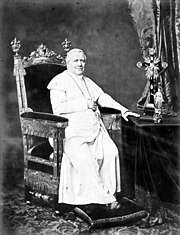
Pius was adamant about his role as the highest teaching authority in the church.[73] He promoted the foundations of Catholic Universities in Belgium and France and supported Catholic associations, with the aim of explaining the faith to non-Catholics. The Ambrosian Circle in Italy, the Union of Catholic Workers in France and the Pius Verein and the Deutsche Katholische Gesellschaft in Germany all tried to bring the Catholic faith in its fullness to people outside the church.[74]
Mariology
Marian doctrines featured prominently in 19th-century theology, especially the issue of the Immaculate Conception of Mary. During his pontificate, petitions increased requesting the dogmatization of the Immaculate Conception. In 1848 Pius appointed a theological commission to analyse the possibility for a Marian dogma.[75] On 8 December 1854 he promulgated the apostolic constitution Ineffabilis Deus is an Apostolic constitution defining the dogma of the Immaculate Conception of the Blessed Virgin Mary.[76]
Encyclicals
Pius issued a record 38 encyclicals. They include:
- Qui pluribus (1846) on faith and religion
- Praedecessores nostros (1847) on aid for Ireland
- Ubi primum 1848 on The Immaculate Conception
- Nostis et nobiscum 1849 on the church in the Papal States
- Neminem vestrum 1854 on the bloody persecution of Armenians
- Cum nuper 1858 on care for clerics
- Amantissimus 1862 on care of the churches
- Meridionali Americae 1865 on the Seminary for the Native Clergy
- Omnem sollicitudinem 1874 on the Greek-Ruthenian Rite
- Quod nunquam 1875 on the Church in Prussia
On 7 February 1862 he issued the papal constitution Ad universalis Ecclesiae, dealing with the conditions for admission to religious orders of men in which solemn vows are prescribed. Unlike popes in the 20th century, Pius IX did not use encyclicals to explain the faith, but to condemn what he considered errors. Pius IX was the first pope to popularize encyclicals on a large scale to foster his views.
First Vatican Council
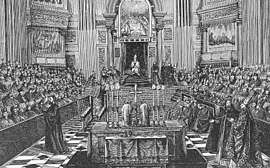
Pius decisively acted on the century-old disagreement between Dominicans and Franciscans regarding the Immaculate Conception of Mary, deciding in favour of the Franciscan view.[77] However, this decision, which he formulated as an infallible dogma, raised a question: Can a pope make such decisions without the bishops? This foreshadowed one topic of the First Vatican Council, which he later convened for 1869.[77] The Pope did consult the bishops beforehand with his encyclical Ubi primum (see below), but insisted on having this issue clarified nevertheless. The council was to deal with papal infallibility, enhancing the role of the papacy and decreasing the role of the bishops.[77] The role of the bishops was to be dealt with at the council, but it was disbanded because of the imminent attack by Italy against the Papal States. Thus, the major achievements of Pius IX are his Mariology and the First Vatican Council.[77]
Influence
Pius IX approved 74 new religious congregations for women alone. In France, Pius IX created over 200 new dioceses and created new hierarchies in several countries.[78]
Last years and death
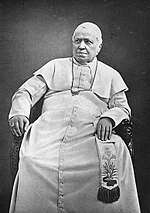
Pius IX lived just long enough to witness the death of his old adversary, Victor Emmanuel II of Italy, in January 1878. As soon as he learned about the seriousness of the situation of the king, he absolved him of all excommunications and other ecclesiastical punishments. Pius IX died one month later on 7 February 1878 at 5:40 pm, of epilepsy, which led to a seizure and a sudden heart attack, while saying the rosary with his staff.[79]
Since 1868, the pope had been plagued first by facial erysipelas and then by open sores on his legs.[80] Nevertheless, he insisted on celebrating daily Mass. The extraordinary heat of the summer of 1877 worsened the sores to the effect that he had to be carried. He underwent several painful medical procedures with remarkable patience. He spent most of his last few weeks in his library, where he received cardinals and held papal audiences.[81] On 8 December, the Feast of the Immaculate Conception, his situation improved markedly to the point that he could walk again.

By February, he could say Mass again on his own in a standing position, enjoying the popular celebration of the 75th anniversary of his First Communion. Bronchitis, a fall to the floor, and rising temperature worsened his situation after 4 February 1878. He continued joking about himself: when the Cardinal Vicar of Rome ordered bell-ringing and non-stop prayers for his recuperation, the pope asked, "Why do you want to stop me from going to heaven?" He told his doctor that his time had come.[82]
Pope Pius IX died on 7 February 1878, aged 85, concluding the longest pontificate in papal history, after that of Saint Peter, whom tradition holds had reigned for 37 years. His last words were, "Guard the church I loved so well and sacredly", as recorded by the cardinals kneeling beside his bedside.[83] His body was originally buried in St. Peter's grotto, but was moved in a night procession on 13 July 1881 to the Basilica of Saint Lawrence outside the Walls. When the cortege approached the Tiber River, a group of anticlerical Romans screaming "Long live Italy! Death to the Pope! Death to the Priests!" threatened to throw the coffin into the river but a contingent of militia arrived to prevent this.[84] The simple grave of Pius IX was changed by his successor John Paul II after his beatification.
Beatification
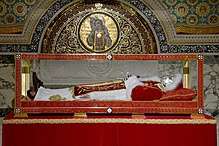
The process for his beatification, which in the early stages was strongly opposed by the Italian government, was begun on 11 February 1907, and recommenced three times.[85] The Italian government had since 1878 strongly opposed beatification of Pius IX. Without Italian opposition, Pope John Paul II declared Pius IX to be Venerable on 6 July 1985 (upon confirming his life of heroic virtue), and beatified him on 3 September 2000 (his annual liturgical commemoration is 7 February).
The beatification of Pius IX was controversial and was criticized by some Jews and Christians because of what was perceived as his authoritarian, reactionary politics; the accusation of abuse of episcopal powers; and antisemitism (most specifically the case of Edgardo Mortara, but also his reinstituting the Roman ghetto).[86]
Legacy
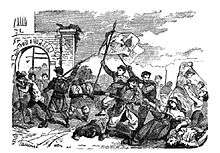

Pius IX celebrated his silver jubilee in 1871, going on to have the longest reign in the history of the post-apostolic papacy, 31 years, 7 months, and 23 days. As his temporal sovereignty was lost, the church rallied around him, and the papacy became more centralized, encouraged by his personal habits of simplicity.[87] Pius IX's pontificate marks the beginning of the modern papacy: from his time on, it has become increasingly a spiritual rather than temporal authority.
Having started as a liberal, Pius IX turned conservative after being chased from Rome. Thereafter, he was considered politically conservative, but a restless and radical reformer and innovator of church life and structures. Church life, religious vocations, new foundations and religious enthusiasm all flourished at the end of his pontificate.[88] Politically, he suffered the isolation of the papacy from most major world powers: "the prisoner of the Vatican" had poor relations with Russia, Germany, the United States, and France, and open hostility with Italy. Yet he was most popular with the remaining Catholic faithful in all these countries, in many of which Pope Pius associations were formed in his support. He made lasting ecclesiastical history with his 1854 infallible decision of the Immaculate Conception, which was the basis for the later dogma on the Assumption. His other lasting contribution is the invocation of the ecumenical council Vatican One, which promulgated the definition of Papal infallibility. With his advice he helped John Bosco found the Salesian Society, for which reason he is also called "don Bosco's Pope".[89]
- In two nights after his 1846 pardon freeing all political prisoners, thousands of Romans with torches roamed to the Quirinal Palace, where Pius IX lived, celebrating the pope with Evvivas, speeches and music through both nights. The Pope went several times to the balcony to give his blessing. On the third day, when his horse-drawn carriage left the Palace to move to the Vatican, Romans unhitched the horses and pulled the papal carriage on their own.[90]
- On 16 November 1848, a crowd of revolutionaries moved to the Quirinal and the Parliament to present to the Pope their demands, especially war against Austria. The Pope reportedly replied, his dignity as head of state and of the church does not permit him to fulfil conditions of rebels. Following this, the Quirinal was covered by cannon fire, which caused several deaths. After that, to save lives, the Pope agreed to a list of proposed ministers, although stating that he would abstain from any cooperation with them.[91]
- After the French troops, who had previously protected the Papal States, left Rome, an Italian army with 60,000 men approached the city, which was defended by only 10,000 papal soldiers. The Pope instructed his hopelessly outnumbered soldiers to give only token resistance and to enter an armistice after the first defeat because the Deputy of Christ does not shed blood. When the old Porta Pia was bombarded, opening a huge hole for the invaders, the Pope asked the white flag to be shown. It was his last act as King of the Papal States.[92] The last papal shot at the Porta Pia was fired by an Austrian alumnus of the Stella Matutina.[93]
- Pius IX was lampooned in a pun on the Italian version of his name (Pio Nono - “Nono” meaning “Ninth”), as Pio No No.
- His occasional mood changes and emotional outbursts have been interpreted as symptoms of his epilepsy.[94][95]
- One enduring popular touch lies in Pius IX's artistic legacy as author of the Italian-language lyrics of Italy's best-known indigenous Christmas carol, "Tu scendi dalle stelle" ("From starry skies descended"), originally a Neapolitan language song written by Alphonsus Liguori.
- During his stay at the Kingdom of Two Sicilies, on 8 September 1849, Pope Pius IX had the experience of a train trip from Portici to Pagani, so he became enthusiastic about this modern invention. When he went back to his seat in Rome, he promoted the growth of a railroad network, starting in 1856 with the Rome and Frascati Rail Road. By 1870, the length of railway lines built in the Papal States was 317 kilometres (197 mi). He also introduced gas lighting and the telegraph to the Papal States.
- To commemorate his term as pope, a street in Montreal is called Pie-IX (Pie-Neuf). There is also a stop on the Montreal Metro system called Pie-IX serving Olympic Stadium. In addition, streets in Santiago, Chile, and Macon, Georgia, are called Pío Nono, Italian for Pius IX and a secondary school with the same name (Pio IX) in Buenos Aires, Argentina. Various sweets in Spain, Latin America, and the Philippines are also named piononos.[96]
Episcopal lineage
The pope's episcopal lineage, or apostolic succession was:[97]
- Cardinal Scipione Rebiba
- Cardinal Giulio Antonio Santorio
- Cardinal Girolamo Bernerio
- Archbishop Galeazzo Sanvitale
- Cardinal Ludovico Ludovisi
- Cardinal Luigi Caetani
- Cardinal Ulderico Carpegna
- Cardinal Paluzzo Paluzzi Altieri degli Albertoni
- Pope Benedict XIII
- Pope Benedict XIV
- Cardinal Enrico Enríquez
- Archbishop Manuel Quintano Bonifaz
- Cardinal Buenaventura Fernández de Córdoba Spínola
- Cardinal Giuseppe Doria Pamphili
- Pope Pius VIII
- Pope Pius IX
See also
Notes
- [joˈvanːi maˈriːa maˈstai feˈrːetːi] English: John Mary Mastai-Ferretti
References
Footnotes
- "IL SEMINARIO PIO DI ROMA E LA DIOCESI DI SENIGALLIA (in Italian)". Papa Pio IX. Retrieved 18 March 2015.
- "Cause of Beatification (in Italian)". Papa Pio IX. 2000. Retrieved 18 March 2015.
- Duffy 1997, pp. 222–235.
- Van Biema, David (27 August 2000). "Not So Saintly?". Time. New York. Retrieved 3 March 2018.
- "Peter's Pence". Washington: United States Conference of Catholic Bishops. Retrieved 23 June 2013.
- See the account of Edward Craven Hawtrey, recorded by Augustus Hare in The Story of My Life, Volume I (Dodd, Mead and Company, New York, 1896), at pages 593 to 599.
- Schmidlin 1922–1939, p. 8.
- "El Papado y la Iglesia naciente en América Latina (1808–1825)". Viajeros.net. Retrieved 23 June 2013.
- Schmidlin 1922–1939, p. 10.
- David I. Kertzer, The Pope Who Would Be King: The Exile of Pius IX and the Emergence of Modern Europe (2018) p. xx.
- O'Carroll 2010, p. 126.
- Duffy 1997, p. 222.
- Valérie Pirie. "The Triple Crown: An Account of the Papal Conclaves – Pius IX (Mastai-Ferretti)".
- Burkle-Young 2000, p. 34.
- In den nächsten zwanzig Monaten war Pius IX. der populärste Mann der Halbinsel; des Rufes „Evviva Pio nono!” war kein Ende mehr. (Seppelt –Löffler: Papstgeschichte, München 1933, p. 408). See archive.org (download)
- Pougeois 1877a, p. 215.
- Schmidlin 1922–1939, p. 23.
- Franzen & Bäumer 1988, p. 357.
- Franzen & Bäumer 1988, p. 363.
- Carroll 2001, pp. 479–494.
- Schmidlin 1922–1939, p. 294.
- Schmidlin 1922–1939, p. 297.
- Schmidlin 1922–1939, p. 299.
- Franzen & Bäumer 1988, p. 364.
- About 1859, ch. 1.
- Schmidlin 1922–1939, p. 45.
- Malone, Richard (25 July 2001). "Historical Overview of the Rosmini Case". L'Osservatore Romano. Baltimore, Maryland. p. 9. Retrieved 3 March 2018 – via EWTN.
- Schmidlin 1922–1939, p. 47.
- Schapiro, J. Salwyn, Ph.D., Modern and Contemporary European History (1815-1921) (Houghton Mifflin Company, The Riverside Press Cambridge, 1921, Revised Edition), pp. 204-205
- Stehle 47
- Schmidlin 1922–1939, p. 52.
- Schmidlin 1922–1939, p. 49.
- Schmidlin 1922–1939, p. 50.
- Schmidlin 1922–1939, p. 53.
- Gagliarducci, Andrea (7 September 2013). "Pope Francis Carries Forward Papal Commitment to Peace". Catholic News Agency. Retrieved 3 March 2018.
- Schmidlin 1922–1939, p. 55.
- Capitelli 2011, pp. 17–147.
- Schmidlin 1922–1939, p. 61.
- Pougeois 1877b, p. 429.
- Pougeois 1877c, p. 258.
- Kertzer 1998.
- Duffy 1997, p. 223.
- Rapport 2009.
- Schmidlin 1922–1939, p. 35.
- De Mattei 2004, p. 33.
- Schapiro, J. Salwyn, Ph.D., Modern and Contemporary European History (1815-1921) (Houghton Mifflin Company, The Riverside Press Cambridge, 1921, Revised Edition), p. 218
- "Milestones: 1861–1865 - Office of the Historian".
- http://www.scholastic.com/browse/subarticle.jsp?id=1106
- "After 125 Years, Vatican, Mexico Restore Ties". 22 September 1992.
- "casa imperial de Mexico". Casaimperial.org. Archived from the original on 17 July 2013. Retrieved 23 June 2013.
- O'Connor 1971.
- Michael 2002.
- Shea 1877, p. 195.
- Reports from Committees. 1867. p. 89.
- Text of the Ecclesiastical Titles Act 1871 as in force today (including any amendments) within the United Kingdom, from legislation.gov.uk.
- "Irish Famine sparked international fundraising". IrishCentral. 10 May 2010.
- Roney, John (2009). Culture and Customs of the Netherlands. Santa Barbara, California: Greenwood Press. p. 64.
- Shea 1877, pp. 205–206.
- Shea 1877, p. 204.
- Don H. Doyle, The Cause of All Nations: An International History of the American Civil War (2014) pp 257-70.
- Doyle, 265-66.
- The American Catholic Historical Researches. 1901. pp. 27–28.
- "John Cardinal McCloskey". New York: Fordham Preparatory School. Retrieved 6 June 2016.
- Schmidlin 1922–1939, p. 212.
- Franzen & Bäumer 1988, p. 362.
- Schmidlin 1922–1939, pp. 141–143.
- Schmidlin 1934, pp. 213–224.
- Shea 1877, pp. 274ff.
- Shea 1877, p. 277.
- Ridley 1976, p. 535.
- Busch 1898a, p. 220.
- Busch 1898b, pp. 43–44.
- Schmidlin 1922–1939, p. 313.
- Schmidlin 1922–1939, pp. 313–315.
- Bäumer 245
- Pope Pius IX. Ineffabilis Deus, December 8 1854
- Franzen & Bäumer 1988, p. 340.
- Duffy 1997, p. 324.
- Schmidlin 1922–1939, pp. 100–102.
- see Martina III, and "Papst Pius IX". damian-hungs.de (in German). Archived from the original on 11 March 2007. Retrieved 11 March 2007.
- Schmidlin 1922–1939, p. 101.
- Schmidlin 1922–1939, p. 102.
- "His Holiness, Venerable Pope Pius IX". Retrieved 22 July 2015.
- Kelly 1987, p. 310; Schmidlin 1922–1939, pp. 103–104.
- Woodward 1996, pp. 310–11.
- Milavec 2007, pp. 159–160.
- Franzen 1991, pp. 336ff.
- Duffy 1997, p. 324; Schmidlin 1922–1939, pp. 292ff.
- IX. Piusz, don Bosco pápája, in: Don Bosco Kalendárium 2011, Szalézi Szent Ferenc Társasága Budapest 2010, site 8.
- Schmidlin 1922–1939, p. 26.
- Schmidlin 1922–1939, pp. 29ff.
- Schmidlin 1922–1939, p. 89.
- Knünz 1956.
- Sirven, Drazkowski & Noe 2007.
- Schneble, H. "Pope Pious IX, epilepsy. Famous people who suffered from epilepsy. Pious IX". Epilepsiemuseum.de. Retrieved 23 June 2013.
- Ocampo, Ambeth R. (9 January 2015). "From Pius IX to 'Pio Nono'". Philippine Daily Inquirer. Retrieved 22 April 2019.
- David M. Cheney, "Bishop Oscar Cantoni", Catholic Hierarchy, retrieved 9 August 2019
Bibliography
- About, E. (1859). The Roman Question. Translated by Coape, H. C. New York: D. Appleton and Company. Retrieved 3 March 2018.CS1 maint: ref=harv (link)
- Burkle-Young, Francis A. (2000). Papal Elections in the Age of Transition, 1878–1922. Lanham, Maryland: Lexington Books. ISBN 978-0-7391-0114-8.CS1 maint: ref=harv (link)
- Busch, Moritz (1898a). Bismarck: Some Secret Pages of His History. 1. London: Macmillan.CS1 maint: ref=harv (link)
- ——— (1898b). Bismarck: Some Secret Pages of His History. 2. London: Macmillan.CS1 maint: ref=harv (link)
- Capitelli, Giovanna (2011). Mecenatismo pontificio e borbonico alla vigilia dell'unità (in Italian). Rome: Viviani Editore. ISBN 978-88-7993-148-9.CS1 maint: ref=harv (link)
- Carroll, James (2001). Constantines's Sword. ISBN 978-0-395-77927-9.CS1 maint: ref=harv (link)
- Davis, William C. (1996). Jefferson Davis: The Man and His Hour. Baton Rouge, Louisiana: Louisiana State University Press. ISBN 978-0-8071-2079-8.CS1 maint: ref=harv (link)
- De Mattei, Roberto (2004). Pius IX. Translated by Laughland, John. Leominster, England: Gracewing. ISBN 978-0-85244-605-8.CS1 maint: ref=harv (link)
- Duffy, Eamon (1997). Saints and Sinners: A History of the Popes. New Haven, Connecticut: Yale University Press.CS1 maint: ref=harv (link)
- Franzen, August (1991). Kleine Kirchengeschichte (in German). Freiburg, Germany: Herder.CS1 maint: ref=harv (link)
- Franzen, August; Bäumer, Remigius (1988). Papstgeschichte (in German). Freiburg, Germany: Herder.CS1 maint: ref=harv (link)
- Kelly, J. N. D. (1987). The Oxford Dictionary of Popes. Oxford: Oxford University Press.CS1 maint: ref=harv (link)
- Kertzer, David I. The Pope Who Would Be King: The Exile of Pius IX and the Emergence of Modern Europe (2018). to 1860
- Kertzer, David I. (1998). The Kidnapping of Edgardo Mortara. New York: Vintage Books. ISBN 978-0-679-76817-3.CS1 maint: ref=harv (link)
- Knünz, Josef (1956). 100 Jahre Stella Matutina, 1856–1956 (in German). Bregenz, Austria: J. N. Teutsch.CS1 maint: ref=harv (link)
- Michael, Prince, of Greece (2002). The Empress of Farewells: The Story of Charlotte, Empress of Mexico. Boston: Atlantic Monthly Press. ISBN 978-0-87113-836-1.CS1 maint: multiple names: authors list (link)
- Milavec, Aaron (2007). Salvation is from the Jews (John 4:22): Saving Grace in Judaism and Messianic Hope in Christianity. Collegeville, Minnesota: Liturgical Press. ISBN 978-0-8146-5989-2.CS1 maint: ref=harv (link)
- O'Carroll, Ciarán (2010). "Pius IX: Pastor and Prince". In Corkery, James; Worcester, Thomas (eds.). The Papacy Since 1500: From Italian Prince to Universal Pastor. Cambridge, England: Cambridge University Press. pp. 125–142. ISBN 978-0-521-50987-9.CS1 maint: ref=harv (link)
- O'Connor, Richard (1971). The Cactus Throne: The Tragedy of Maximilian and Carlotta. New York: G. P. Putnam's Sons.CS1 maint: ref=harv (link)
- Pougeois, Alexandre (1877a). History of Pius IX: His Pontificate and His Century. 1. Paris.CS1 maint: ref=harv (link)
- ——— (1877b). History of Pius IX: His Pontificate and His Century. 2. Paris.CS1 maint: ref=harv (link)
- ——— (1877c). History of Pius IX: His Pontificate and His Century. 3. Paris.CS1 maint: ref=harv (link)
- Rapport, Mike (2009) [2008]. 1848: Year of Revolution. New York: Basic Books. ISBN 978-0-7867-4368-1.CS1 maint: ref=harv (link)
- Ridley, Jasper (1976). Garibaldi. New York: Viking Press.CS1 maint: ref=harv (link)
- Schmidlin, Josef (1922–1939). Papstgeschichte (in German). Munich: Köstel-Pusztet.CS1 maint: ref=harv (link)[volume needed]
- ——— (1934). Papstgeschichte (in German). 2. Munich: Köstel-Pusztet.CS1 maint: ref=harv (link)
- Shea, John Gilmary (1877). The Life of Pope Pius IX. New York: n.p.CS1 maint: ref=harv (link)
- Sirven, Joseph I.; Drazkowski, Joseph F.; Noe, Katherine H. (2007). "Seizures among Public Figures: Lessons Learned from the Epilepsy of Pope Pius IX". Mayo Clinic Proceedings. 82 (12): 1535–1540. doi:10.1016/S0025-6196(11)61100-2. ISSN 1942-5546. PMID 18053463.CS1 maint: ref=harv (link)
- Woodward, Kenneth L. (1996). Making Saints: How the Catholic Church Determines Who Becomes a Saint, Who Doesn't, and Why. New York: Simon and Schuster. ISBN 978-0-684-81530-5.CS1 maint: ref=harv (link)
Further reading
- Barwig, Regis N. (1978). More Than a Prophet: Day By Day With Pius IX. Altadena: Benziger Sisters.
- Chadwick, Owen. A History of the Popes 1830-1914 (2003). online
- Chadwick, Owen. The Popes and European Revolution (1981) 655pp excerpt; also online
- Chiron, Yves, Pope Pius IX: The Man and The Myth, Angelus Press, Kansas City, 2005 ISBN 1-892331-31-4
- Corcoran, James A. "Pius IX and His Pontificate," The American Catholic Quarterly Review, Vol. III, 1878.
- De Cesare, Raffaele (1909). The Last Days of Papal Rome. London: Archibald Constable & Co. p. 449.
- Hales, E. E. Y. Pio Nono: A study in European politics and religion in the nineteenth century (2013) 352pp excerpt; also online
- Hasler, August Bernhard (1981). How the Pope Became Infallible: Pius IX and the Politics of Persuasion. Doubleday.
- Kertzer, David I. (2004). Prisoner of the Vatican: The Popes' Secret Plot to Capture Rome from the New Italian State. Houghton Mifflin. ISBN 978-0-618-22442-5.
- Mooney, John A. (1892). "Pius IX and the Revolution, 1846–1848". The American Catholic Quarterly Review. 17: 137–161. Retrieved 3 March 2018.
Other languages
- Acta et decreta Leonis XIII, P.M. Vol I–XXII, Rome, 1881, ff
- Acta et decreta Pii IX, Pontificis Maximi, Vol. I–VII, Romae 1854 ff
- Actae Sanctae Sedis, (ASS), Romae, Vaticano 1865
- Boudou, L. (1890). Le S. Siege et la Russie, Paris
- Capitelli, Giovanna, Mecenatismo pontificio e borbonico alla vigilia dell'unità, Viviani Editore, Rome, 2011 ISBN 8879931482
- Hasler, August Bernhard (1977). Pius IX. (1846–1878) päpstliche Unfehlbarkeit und 1. Vatikanisches Konzil. (= Päpste und Papsttum Bd. 12). 2 volumes, 1st ed. Hiersemann, Stuttgart, ISBN 3-7772-7711-8
- Martina, S.J. Pio IX (1846–1850). Roma: Editrice Pontificia Universita Gregoriana. Vol I–III, 1974–1991.
- Martina, Giacomo: PIO IX, beato. In: Massimo Bray (ed.): Enciclopedia dei Papi, Istituto della Enciclopedia Italiana, Vol. 3 (Innocenzo VIII, Giovanni Paolo II), Rome, 2000, OCLC 313581724
- Seifert, Veronika Maria (2013). Pius IX. – der Immaculata-Papst. Von der Marienverehrung Giovanni Maria Mastai Ferretis zur Definierung des Immaculata-Dogmas. V&R unipress. Göttingen. ISBN 978-3-8471-0185-7.
- Sylvain (1878). Histoire de Pie IX le Grand et de son pontificat. Vol I, II. Paris
External links
| Wikisource has original text related to this article: |
| Wikimedia Commons has media related to Pius IX. |
| Wikiquote has quotations related to: Pope Pius IX |
- Pope Pius IX (His Encyclical Writings)
- Biography with pictures (in German)
- Pope Pius IX: text with concordances and frequency list
- Catholic-Hierarchy entry
- Derek Michaud. "Pius IX (1792–1878)". Boston Collaborative Encyclopedia of Western Theology.
| Catholic Church titles | ||
|---|---|---|
| Preceded by Mario Ancaiani |
Archbishop of Spoleto 21 May 1827 – 17 December 1832 |
Succeeded by Ignazio Giovanni Cadolino |
| Preceded by Giacomo Giustiniani |
Bishop of Imola 17 December 1832 – 16 June 1846 |
Succeeded by Gaetano Baluffi |
| Preceded by Gregory XVI |
Pope 16 June 1846 – 7 February 1878 |
Succeeded by Leo XIII |

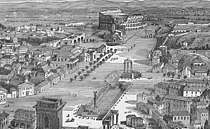
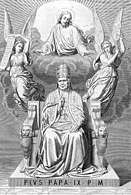
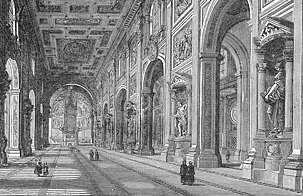
_by_Karl_Bryullov.jpg)



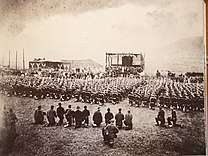


.jpg)